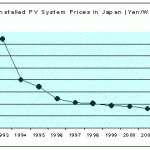The future of renewable energy in India looks bright. There have been significant progress in recent years in increasing its renewable energy capacity and reducing its reliance on fossil fuels. According to the Ministry of New and Renewable Energy, India’s renewable energy capacity has more than doubled over the past decade, from 35 GW in 2011 to over 85 GW in 2021. This impressive growth is due in large part to the government’s ambitious renewable energy target of 175 GW by 2022, which was later revised to 450 GW by 2030.
One of the main drivers of India’s renewable energy boom is the falling cost of renewable technologies. In recent years, the cost of solar and wind energy has fallen significantly, making it more economically viable for both households and businesses. In addition, the government has implemented a number of policies and incentives to encourage the adoption of renewable energy, including the National Solar Mission, which aims to increase the country’s solar capacity to 100 GW by 2022.
In terms of specific technologies, solar energy has seen the most growth in India. The country is home to some of the largest solar power plants in the world, including the Bhadla Solar Park in Rajasthan, which has a capacity of 2.245 GW. In addition, there has been a significant increase in the number of rooftop solar installations, as more and more households and businesses opt for clean, reliable, and cost-effective energy.
Wind energy is another important source of renewable energy in India. The country is home to the largest wind farm in the world, the Kutch Wind Farm in Gujarat, which has a capacity of over 1.5 GW. In addition, there are several other large wind farms scattered throughout the country, with a total capacity of over 34 GW.
Bioenergy, including biogas and biomass, is also an important source of renewable energy in India. The country has a large agricultural sector and a large population, both of which generate significant amounts of organic waste that can be converted into bioenergy. Biogas plants, which convert organic waste into methane, are particularly popular in rural areas, where they provide a clean and reliable source of energy for cooking and lighting.
Despite this progress, there are still challenges to the widespread adoption of renewable energy in India. One of the main challenges is the availability of financing. Many households and businesses, particularly in rural areas, do not have access to the capital needed to invest in renewable energy technologies. In addition, there are still barriers to the adoption of renewable energy in the form of regulatory and policy hurdles, as well as a lack of awareness and education about the benefits of renewable energy.
To address these challenges, the government has implemented a number of policies and initiatives to support the adoption of renewable energy. These include the Pradhan Mantri Kisan Urja Suraksha evam Utthan Mahabhiyan (PM-KUSUM), which aims to promote the adoption of renewable energy by farmers, and the Deen Dayal Upadhyaya Gram Jyoti Yojana (DDUGJY), which aims to provide electricity to all households in the country by 2020.
However, there are still challenges to overcome, including the availability of financing and regulatory and policy hurdles. With continued efforts to promote the adoption of renewable energy, India can play a leading role in the global transition to a clean and sustainable energy future.


